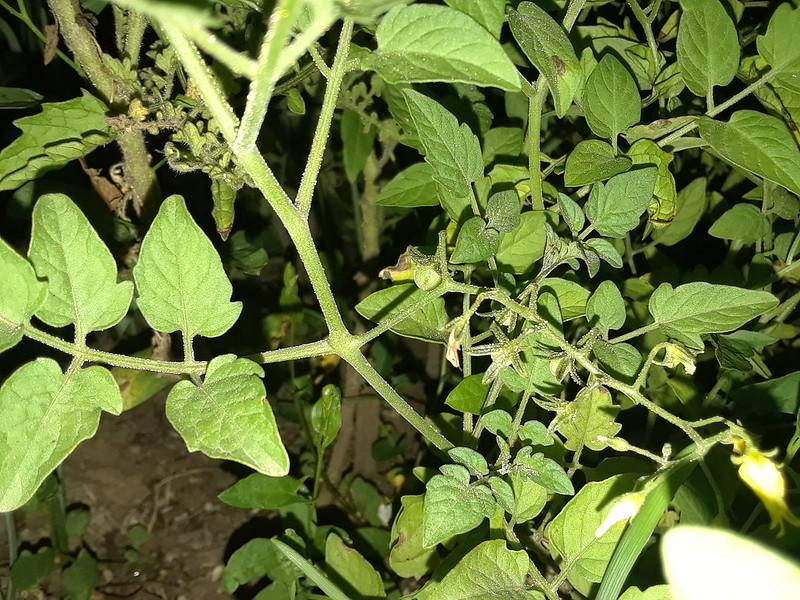

 1
1




 1
1




Joseph Lofthouse wrote:
I don't have a good track record of keeping plants alive as houseplants overwinter. I do it every winter. Some survive, some die. I am usually able to grow a new generation of seed overwinter, but it's hit and miss. I'm intending to heat the greenhouse for a while this fall. That may help.
I pulled two odd plants that were growing in the S peruvianum patch. They have leaves that are serrated/wrinkled, which I typically think of as a habrochaites trait. I managed to break the roots from the vines, so I stuck them in water to see if they will grow new roots.
I'm intending to take photos of the larger fruits (by weight) in the next few weeks when I pick tomatoes.




 20180828_195032 by Andrew Barney, on Flickr
20180828_195032 by Andrew Barney, on Flickr 2
2




“The most important decision we make is whether we believe we live in a friendly or hostile universe.”― Albert Einstein






















 3
3




Western Montana gardener and botanist in zone 6a according to 2012 zone update.
Gardening on lakebed sediments with 7 inch silty clay loam topsoil, 7 inch clay accumulation layer underneath, have added sand in places.




 1
1




Leandro argent wrote:Hi, I'm new in the forum. Excuse my English, it's not my natural language. I live in Argentina. I love permies and I'm just fascinated about your growing works Joseph.
My question here is, how do you know that a wild species will pollinate your cultivated tomatos?
In this area grows a wild tomato (solanum sisymbriifolium) called tomatillo by us. I would like to know if is there any chance for it to pollinate my tomato plants. I'm intending to start a "dry whether resistant tomato" growing project.
Western Montana gardener and botanist in zone 6a according to 2012 zone update.
Gardening on lakebed sediments with 7 inch silty clay loam topsoil, 7 inch clay accumulation layer underneath, have added sand in places.




 1
1










 1
1




![Filename: corneliomuleri-diversity.jpg
Description: Comparing original fruit size with current fruit size in wild tomato S corneliomulleri [Thumbnail for corneliomuleri-diversity.jpg]](/t/47793/a/69309/corneliomuleri-diversity.jpg)
![Filename: peruvianum-0912181721-00.jpg
Description: Some of the larger fruits of S pervianum [Thumbnail for peruvianum-0912181721-00.jpg]](/t/47793/a/69310/peruvianum-0912181721-00.jpg)
![Filename: habrochaites-3-locules-2018.jpg
Description: Larger S habrochaites fruits with 3 locules. [Thumbnail for habrochaites-3-locules-2018.jpg]](/t/47793/a/69313/habrochaites-3-locules-2018.jpg)
 2
2




Western Montana gardener and botanist in zone 6a according to 2012 zone update.
Gardening on lakebed sediments with 7 inch silty clay loam topsoil, 7 inch clay accumulation layer underneath, have added sand in places.






 1
1




![Filename: tomato-interspecies-compatibility-plus.png
Description: Interspecies compatibility between wild tomato species. [Thumbnail for tomato-interspecies-compatibility-plus.png]](/t/47793/a/69357/tomato-interspecies-compatibility-plus.png)
 3
3




Joseph Lofthouse wrote:This is my best guess at interspecies crossing ability within tomatoes. The solid lines are fully compatible bi-directional crosses. The black dotted lines are one way pollen flow only. The red dotted lines are possible pollen flows that depend on the particular genetics of specific offspring of the inter-species crosses. As with anything biological, these are approximations, and once in a million occurrences are possible, since plants produce pollen super prolifically. I didn't include all 13 tomato species in the diagram, just the 9 that I'm working with in my garden.
Western Montana gardener and botanist in zone 6a according to 2012 zone update.
Gardening on lakebed sediments with 7 inch silty clay loam topsoil, 7 inch clay accumulation layer underneath, have added sand in places.

 1
1




 1
1




Joseph Lofthouse wrote:So far this spring, I have planted about 3000 seeds for the Beautifully Promiscuous and Tasty Tomato project. 1/3 of them as transplants, and the rest were direct seeded. I distributed about 5000 seeds to more than 100 collaborators.
We devoted a lot of resources and labor into selecting for promiscuous flowers and out-crossing plants. This growing season, we are selecting for blight and disease tolerance back east where the ecosystem is problematic for tomatoes.
Oh, and can't forget to mention the taste. Oh my. Intending to select for fruitiness this summer, and against tomato-like taste.
Western Montana gardener and botanist in zone 6a according to 2012 zone update.
Gardening on lakebed sediments with 7 inch silty clay loam topsoil, 7 inch clay accumulation layer underneath, have added sand in places.





![Filename: 0607191123-00.jpg
Description: Solanum physalifolium [Thumbnail for 0607191123-00.jpg]](/t/47793/a/79969/0607191123-00.jpg)




Joseph Lofthouse wrote:This summer was amazing in the wild tomato patch... So many pollinators of so many species!
Bumblebees were very common, up to 5 species at the same time.
How's this for a promiscuous tomato flower?
So easy to swap pollen and microbes!
(source)
Comparing an interspecies tomato flower from my breeding project (huge!) with a typical flower from a domestic variety. If I were a bee, I know which flower I'd find most attractive.
Species unknown:
A huge bumblebee:
A tiny bumblebee?
This tomato has been very popular. It doesn't meet the breeding goals of the project, but it has captured people's imaginations.
Siblings to the previous plant:
Another sibling:
So much diversity to work with among the wild species:
These are both the same species (Solanum habrochaites):
 7
7








Joseph Lofthouse wrote:The earliest Solanum physalifolium have germinated and are fairly large plants. Hmm.. A source of cold tolerance in Solanum??? That's the weedy species that I allow to grow for the Colorado Potato Beetles. I hope that this is the year that I finally start a domestication project on it, or at least a seed saving project.





 2
2





|
mooooooo ..... tiny ad ....
The new kickstarter is now live!
https://www.kickstarter.com/projects/paulwheaton/garden-cards
|









